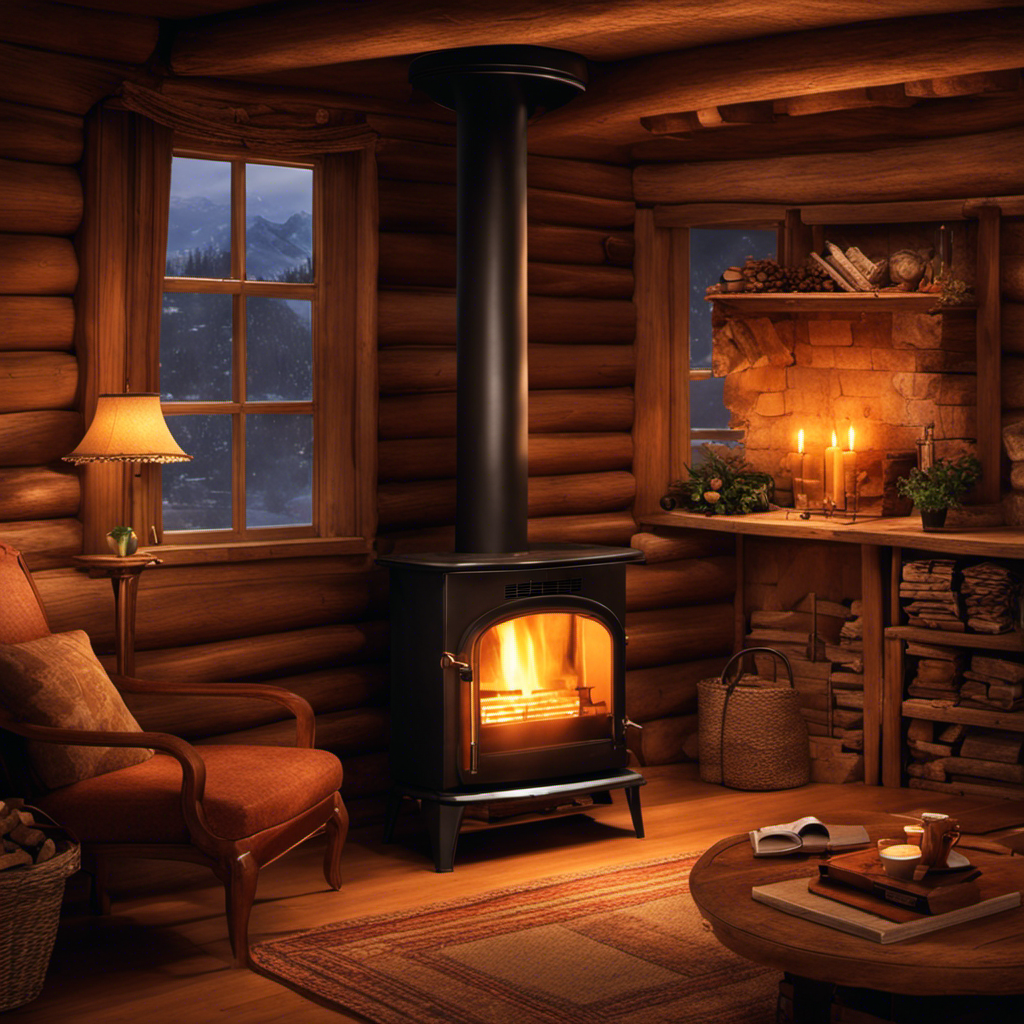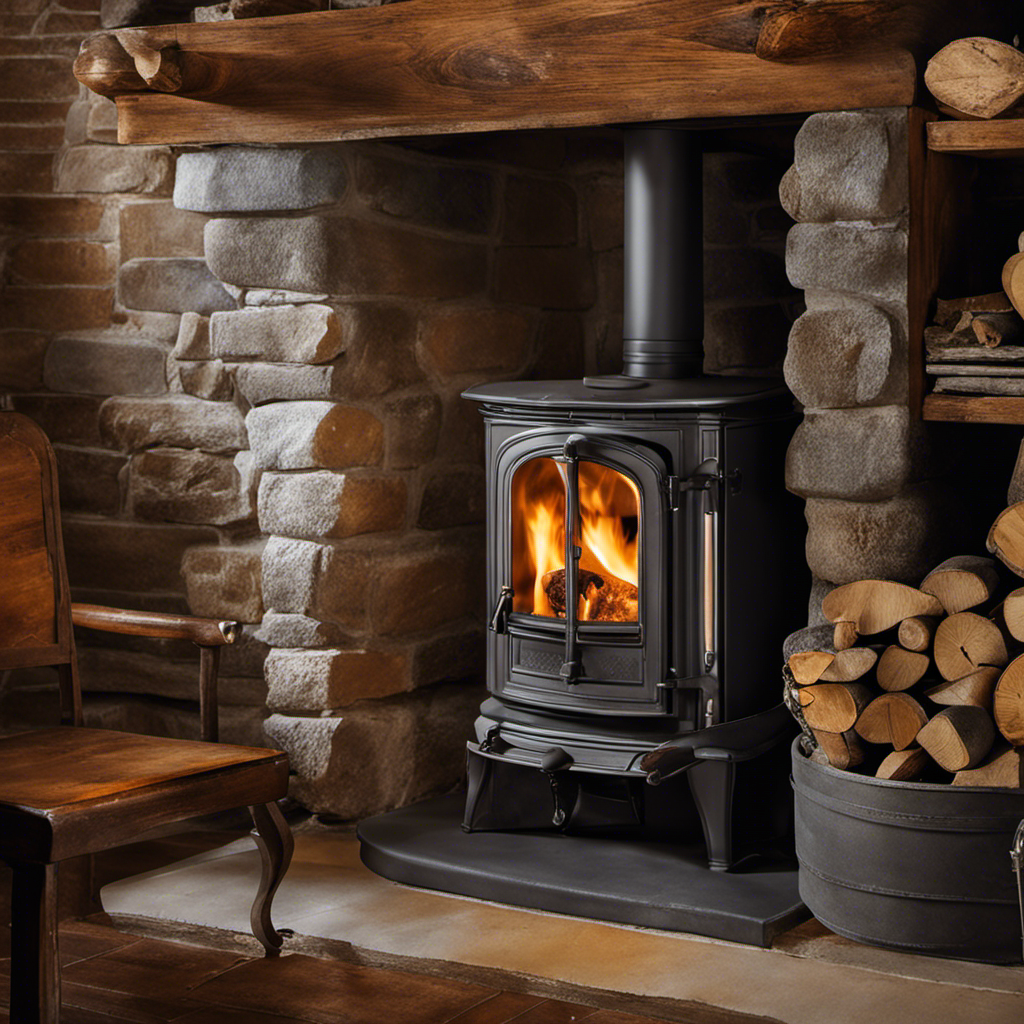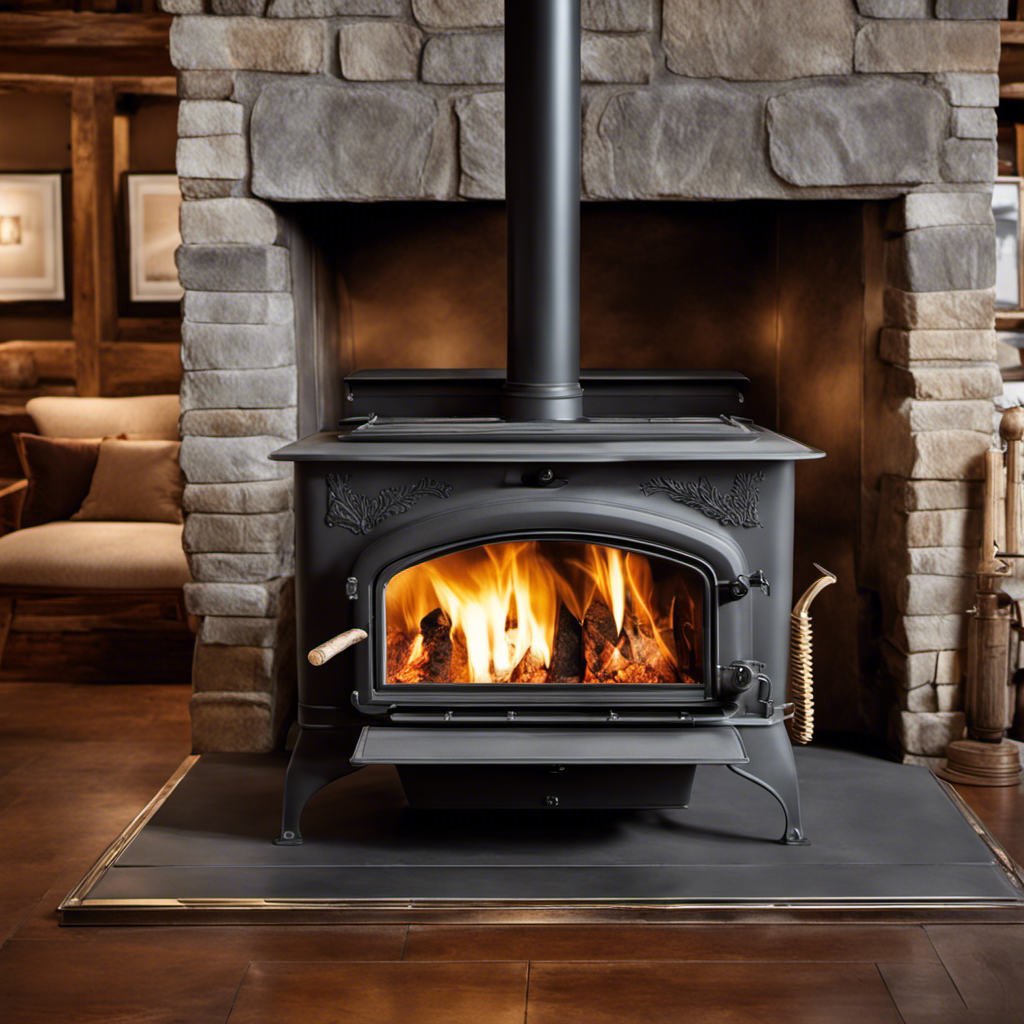As an experienced lover of fire, I have mastered the skill of maintaining a wood stove. It is like taking care of a living creature, making sure it gets the proper type of wood, arrangement, and ventilation.
In this article, I’ll share my expert tips on prolonging the fiery glow, from choosing the perfect wood to managing ash and embers.
Get ready to master the art of keeping your wood stove burning bright, even on the chilliest winter nights.
Key Takeaways
- Use dry and seasoned hardwoods like oak, maple, and birch to keep the fire going longer and produce more heat.
- Properly store firewood off the ground and in a well-ventilated area to maintain its quality.
- Maintain proper airflow by regularly cleaning the chimney and avoiding common mistakes like using wet or unseasoned wood.
- Regularly clean out the ash pan, use a fireplace screen, and keep the firebox clear to manage ash and embers effectively.
Choosing the Right Wood for Your Stove
I need to figure out which type of wood will burn the most efficiently in my stove.
When it comes to splitting firewood, there are a few things to consider. First, you want to make sure the wood is dry and seasoned. Wet or green wood won’t burn as efficiently and can cause creosote buildup in your stove.
Hardwoods like oak, maple, and birch are great options as they burn longer and produce more heat. Softwoods like pine and spruce burn faster but may not provide as much heat.
Storing firewood properly is also crucial. It should be stacked off the ground, in a well-ventilated area, and covered to protect it from rain or snow.
By choosing the right wood and properly storing it, you’ll ensure a more efficient burn in your stove and a longer-lasting fire.
Now let’s move on to building a proper fire structure.
Building a Proper Fire Structure
To build a proper fire structure, start by carefully arranging the kindling and then add the larger logs on top. This ensures a steady and efficient burn. Here’s a step-by-step guide to help you get it right:
-
Gather your firewood: Proper firewood storage is essential to maintain its dryness. Make sure to store it in a well-ventilated area, off the ground, and protected from rain or snow.
-
Prepare the kindling: Collect small, dry twigs and crumple newspaper to create a base for your fire. Place them in a crisscross pattern at the bottom of the stove.
-
Layer the larger logs: Carefully stack the larger logs on top of the kindling, leaving enough space for air circulation. Arrange them in a way that allows the fire to breathe and burn evenly.
-
Maintain your chimney: Regular chimney maintenance is crucial for safety and efficiency. Schedule annual inspections and cleanings to remove any creosote buildup, which can lead to chimney fires.
Maintaining Airflow for Efficient Burning
The key to efficient burning is maintaining a steady airflow throughout the wood stove. This ensures that the fire burns at the optimal temperature, resulting in better heat output and reduced emissions. Regular chimney cleaning is crucial to maintain proper airflow. A dirty chimney can become clogged with creosote and debris, obstructing the passage of smoke and limiting the airflow. This can lead to poor combustion and increased risk of chimney fires. Common mistakes that can hinder airflow in a wood stove include closing the damper too much, using wet or unseasoned wood, and blocking the air vents. It is important to regularly inspect and clean the chimney, as well as follow proper wood burning practices, to ensure optimal airflow and efficient burning in a wood stove.
| Importance of Regular Chimney Cleaning | Common Mistakes That Can Hinder Airflow |
|---|---|
| Reduces risk of chimney fires | Closing the damper too much |
| Prevents creosote buildup | Using wet or unseasoned wood |
| Ensures proper airflow | Blocking the air vents |
Managing Ash and Embers
There are several ways to manage ash and embers, such as regularly cleaning out the ash pan and using a fireplace screen to contain any stray embers. Here are some tips to help keep your wood stove fire going while minimizing ash and preventing embers from escaping:
-
Clean the ash pan: Remove the ash regularly to prevent build-up, which can hinder airflow and reduce the efficiency of your fire.
-
Use a fireplace screen: Place a sturdy screen in front of the wood stove to catch any flying embers and prevent them from landing on flammable surfaces.
-
Keep the firebox clear: Remove any debris or unburned wood from the firebox before starting a new fire. This ensures proper airflow and reduces the likelihood of embers escaping.
-
Use proper firewood: Burn dry, seasoned firewood to minimize the amount of ash produced and prevent excessive embers. Wet or green wood can create more ash and increase the risk of embers escaping.
Tips for Extending the Burning Time of Your Fire
I’ve found that adding a layer of newspaper underneath the logs helps with extending the burning time of my fire.
When it comes to fuel selection, using hardwoods like oak or maple is ideal as they burn longer and produce more heat compared to softwoods.
It’s also important to properly store your firewood to ensure it’s dry and ready to burn. Moisture content plays a crucial role in the burning time of your fire. Storing firewood in a dry, well-ventilated area, such as a woodshed or garage, will help prevent it from absorbing moisture. Additionally, stacking the firewood off the ground and covering it with a tarp can further protect it from rain or snow.
Frequently Asked Questions
How Often Should I Clean My Wood Stove?
I clean my wood stove every 1-2 weeks to ensure optimal performance. Regular cleaning helps prevent creosote buildup, which can lead to chimney fires. Use a brush and vacuum to remove ash, debris, and soot.
Can I Burn Treated or Painted Wood in My Wood Stove?
Burning treated or painted wood in a wood stove can release toxic chemicals into the air. To ensure safety, it’s important to only burn dry, seasoned wood that is free from any chemicals or treatments.
What Safety Precautions Should I Take When Using a Wood Stove?
When using a wood stove, it’s important to take safety measures and ensure proper ventilation. This includes keeping flammable materials away, using a screen to prevent sparks, and regularly cleaning the stove.
How Can I Prevent Creosote Buildup in My Chimney?
To prevent creosote buildup in my chimney, I make sure to regularly clean and inspect it. I also use seasoned firewood, maintain proper airflow, and avoid burning materials that produce excessive smoke or soot.
How Do I Know When It’s Time to Add More Wood to the Fire?
When it’s time to add more wood to the fire, I look for signs like dwindling flames and a decrease in heat. It’s all about time management and using high-quality wood for a long-lasting, cozy fire.
Conclusion
In conclusion, by selecting the right wood, building a proper fire structure, maintaining airflow, and managing ash and embers, you can keep a fire going in your wood stove efficiently and effectively.
Remember, like a warm embrace on a chilly winter’s night, a well-tended fire can bring comfort and coziness to your home.
So, follow these tips and enjoy the soothing warmth of your wood stove all season long.
Growing up surrounded by the vast beauty of nature, Sierra was always drawn to the call of the wild. While others sought the comfort of the familiar, she ventured out, embracing the unpredictable and finding stories in the heartbeat of nature.
At the epicenter of every remarkable venture lies a dynamic team—a fusion of diverse talents, visions, and passions. The essence of Best Small Wood Stoves is crafted and refined by such a trio: Sierra, Logan, and Terra. Their collective expertise has transformed the platform into a leading authority on small wood stoves, radiating warmth and knowledge in equal measure.











